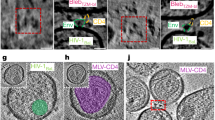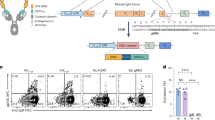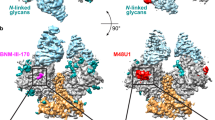Abstract
The CD4 antigen has been subverted as a receptor by the human and simian immunodeficiency viruses (HIV-1, HIV-2 and SIV)1–4. Several groups5–9 have reported that recombinant, soluble forms of the CD4 molecule (sCD4) block the infection of T lymphocytes by HIV-1, as CD4 binds the HIV envelope glycoprotein, gp120, with high affinity10,11. We now report that sCD4 blocks diverse strains of HIV-1, HIV-2 and SIV, but is less effective for HIV-2. The blocking effect is apparent even after adsorption of virions to CD4 cells. Soluble CD4 prevents HIV infection of T-lymphocytic and myelomonocytic cell lines, but neither sCD4 nor anti-CD4 antibodies inhibit infection of glioma and rhabdomyosarcoma cell lines.
This is a preview of subscription content, access via your institution
Access options
Subscribe to this journal
Receive 51 print issues and online access
$199.00 per year
only $3.90 per issue
Buy this article
- Purchase on SpringerLink
- Instant access to full article PDF
Prices may be subject to local taxes which are calculated during checkout
Similar content being viewed by others
References
Dalgleish, A. G. et al. Nature 312, 763–766 (1984).
Klatzmann, D. et al. Nature 312, 767–768 (1984).
Sattentau, Q. J. et al. AIDS 2, 17–21 (1988).
Sattentau, Q. J. & Weiss, R. A. Cell 52, 631–633 (1988).
Smith, D. H. et al. Sciences 238, 1704–1707 (1987).
Fisher, R. A. et al. Nature 331, 76–78 (1988).
Hussey, R. E. et al. Nature 331, 78–81 (1988).
Deen, K. C. et al. Nature 331, 82–84 (1988).
Traunecker, A., Luke, W. & Karjalainen, K. Nature 331, 84–86 (1988).
McDougal, J. S. et al. Science 231, 382–385 (1986).
Lasky, L. A. et al. Cell 50, 975–985 (1987).
Harada, S., Koyanagi, Y. & Yamamoto, N. Science 229, 563–566 (1985).
Weiss, R. A. et al. Nature 324, 572–575 (1986).
Stein, B. S. et al. Cell 49, 659–668 (1987).
McClure, M. O., Marsh, M. & Weiss, R. A. EMBO J. 7, 513–518 (1988).
Maddon, P. J. et al. Cell 54, 865–874 (1988).
Sattentau, Q. J., Dalgleish, A. G., Weiss, R. A. & Beverley, P. C. L. Science 234, 1120–1123 (1986).
Åsjö, B. et al. Virology 157, 359–365 (1987).
Clapham, P. R. et al. Virology 158, 44–51 (1987).
Dewhurst, K. et al. FEBS Lett. 213, 138–143 (1987).
Chiodi, F. et al. J. Virol 61, 1244–1247 (1987).
Cheng-Mayer, E. et al. Proc. natn. Acad. Sci. U.S.A. 84, 3526–3530 (1987).
Srinivasan, A. et al. Arch. Virol. 99, 21–30 (1988).
McAllister, R. M. et al. Int. J. Cancer 20, 206–212 (1977).
Stratton, M. R., Reeves, B. R. & Cooper, C. S. Nature 337, 311–312 (1989).
Doyle, C. & Strominger, J. Nature 330, 256–259 (1987).
Chanh, T. C., Dreesman, G. & Kennedy, R. C. Proc. natn. Acad. Sci. U.S.A. 84, 3891–3895 (1987).
Landau, N. R., Warton, M. & Littman, D. R. Nature 334, 159–162 (1988).
Peterson, A. & Seed, B. Cell 54, 65–72 (1988).
McClure, M. O. et al. Nature 330, 487–489 (1987).
Lowy, I. et al. Cell 22, 817–824 (1980).
Maddon, P. J. et al. Cell 47, 333–348 (1986).
Koenig, S. et al. Science 233, 1089–1093 (1986).
Wiley, C. A., Schrier, R. D., Nelson, J. A., Lampert, P. W. & Oldstone, M. B. A. Proc. natn. Acad. Sci. U.S.A. 83, 7089–7093 (1986).
Clapham, P. R., Nagy, K. & Weiss, R. A. Proc. natn. Acad. Sci. U.S.A. 81, 3083–3086 (1984).
Author information
Authors and Affiliations
Rights and permissions
About this article
Cite this article
Clapham, P., Weber, J., Whitby, D. et al. Soluble CD4 blocks the infectivity of diverse strains of HIV and SIV for T cells and monocytes but not for brain and muscle cells. Nature 337, 368–370 (1989). https://doi.org/10.1038/337368a0
Received:
Accepted:
Issue date:
DOI: https://doi.org/10.1038/337368a0
This article is cited by
-
Proteasome-independent degradation of HIV-1 in naturally non-permissive human placental trophoblast cells
Retrovirology (2009)
-
Variation in HIV-1 R5 macrophage-tropism correlates with sensitivity to reagents that block envelope: CD4 interactions but not with sensitivity to other entry inhibitors
Retrovirology (2008)
-
Novel antiviral agents targeting HIV entry and transmission
Virologica Sinica (2007)
-
Neuroimmunity and the Blood–Brain Barrier: Molecular Regulation of Leukocyte Transmigration and Viral Entry into the Nervous System with a Focus on NeuroAIDS
Journal of Neuroimmune Pharmacology (2006)
-
International NeuroAIDS: prospects of HIV-1 associated neurological complications
Cell Research (2005)



